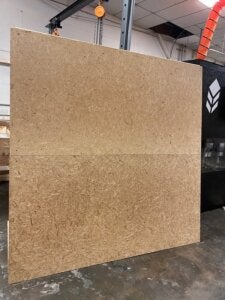Construction is a major carbon emitter. The manufacture of cement alone accounts for eight percent of the world’s emissions. But humanity certainly isn’t about to stop building things—in fact, fixing the housing shortage should be near the top of our list of problems to solve. So we need to find more sustainable ways to build, and if they can be cheaper to boot, even better.
Companies are working on all kinds of solutions in the sustainable construction space, from 3D printed homes to carbon-negative concrete. A new potential solution is joining their ranks, and a recent infusion of funding indicates this unique idea could have a lot of promise.
Plantd is a startup that makes engineered building materials out of grass. That’s right—grass! The fastest-growing perennial grass on Earth, according to the company.
Based in Durham, North Carolina, Plantd closed its Series A funding round to the tune of $10 million in January. Two of its three cofounders are former SpaceX engineers.
What’s Great About Grass
Like trees, grass captures and stores carbon as it grows, and some varieties can even capture more carbon than trees do. This is mostly because of their growth speed. Think about it: a tree takes at least 10 years—if not 20 or more—to reach a mass large enough to be used for lumber, whereas grass can be harvested multiple times in one season (though there is at least one startup out there that’s engineering trees that grow faster and capture more carbon).
After testing several different types of grass and other raw materials, Planted settled on a perennial (meaning it grows back every year and doesn’t need to be re-planted) long grass that can grow 20 to 30 feet and absorb up to 30 tons of carbon in a year.
Though grass is obviously softer than wood, it contains a similar cellulose fiber that can be broken down then reconstituted and engineered in such a way that the final product is even stronger than wood (check out this video that made the rounds on LinkedIn last year: a regular wood panel and a Plantd panel are subjected to a sledgehammer, and just one of the two withstands the test).

Plantd makes structural building panels for wall sheathing, roof decking, and subflooring, and they say their product outcompetes wood on every metric: it’s stronger, cheaper, lighter, more moisture-resistant, and captures more carbon—all for the same cost as wood. The panels are meant to be a replacement for a plywood-like material called traditional oriented strand board, or OSB. Custom-built machinery uses heat and pressure to press shredded grass into panels, with a standard four-by-eight-foot panel using about 50 pounds of grass.
The Difference
Plantd’s CEO and co-founder Josh Dorfman told Forbes that the panels will allow contractors to build homes using fewer two-by-fours. “Our panels are strong enough to maintain more of the structural integrity of a home compared to the conventional wood-based panels used today,” he said. “Instead of using two two-by-fours per panel when constructing a wall, a builder will only have to use one. This leads to clear cost savings, and the savvy contractor will also recognize that fewer two-by-fours means fewer thermal gaps in a building’s envelope where air can escape.” That means better energy efficiency, and ultimately lower electric and gas bills for homeowners.
Plantd is partnering with a local farmer near Durham to start growing several acres of its grass this year. Dorfman expects that scaling up and finding more farmers won’t be difficult, because many farmers in North Carolina who have historically grown tobacco are looking to replace it with a more sustainable, better-paying crop.
For processing the grass and turning it into super-strong panels, Plantd is developing its production technology in-house, and says it will be automated, modular, electric, and low-emissions, with 80 percent of the carbon that enters their factory in the form of grass getting locked away in the building materials that leave it. They estimate they’ll be able to produce the same amount of material that’s produced from wood using nine times less land (15,000 acres versus 140,000 acres).
Going Forward
Dorfman got the idea for his company while trying to build a sustainable furniture business during the pandemic. As supply chains crumbled, the cost of building materials went up even as their quality went down. “That frustration led to my interest in launching a materials company using alternative biomass to trees,” Dorfman said. He and his cofounders launched Plantd in the spring of 2021.
The company plans to use its Series A funding to establish its agricultural supply chain and build its first pieces of manufacturing equipment. They hope to make their panels a standard in the industry, and their ultimate vision is to build the “factory of the future” to enable mass adoption of the product. They’ll have their work cut out for them; according to the company’s website, the US market for building panels is $26 billion, and the global market for engineered wood products is worth $280 billion.
“Our value proposition is about affordability, durability, and sustainability,” Dorfman said. “We believe the future is going to be abundant. With Plantd, the way to solve climate change is to build more, not less, because every new home and building is an opportunity to lock away atmospheric carbon.”
Image Credit: Plantd
* This article was originally published at Singularity Hub

0 Comments